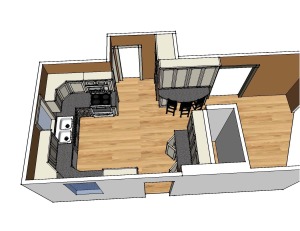When planning a kitchen remodel timeline, most homeowners want to know the best time to start in order to be completed by a specific date. Therefore, at Cedars, we often get asked the question, “How long does it take to remodel a kitchen?”
There are 3 basic phases of a kitchen remodel: design, planning and production. Your timeline will depend on the size and type of kitchen remodel, but it generally takes between four to six weeks to remodel, if you do not include the planning and design phases.
Planning and Design Timeline of a Kitchen Remodel
If you are considering a kitchen remodel, it is extremely important to take as much time as you need to plan. Each and every detail will need to be thought through and planned for, and you want the end result to be exactly as you’ve envisioned it. If you have the ability to print out or email pictures of elements that you would like to be incorporated into the design of your kitchen, please do this. Pictures can save on design time and ensure accuracy in communicating your vision.
It is very important to work with a design/build company that is able to show you design and product options, and their associated costs. It is also important to clearly communicate your budget to your design build company so they can help you keep watch on your budget throughout the process. At Cedars Woodworking, we provide our clients with 3D renderings of their kitchen design so that they know what their future kitchen will look like. We believe this service is in the best interest of the client-provider relationship. After all, it is much easier to make a change to a drawing than it is to make a change after the project is underway. Clear communication is paramount through the remodel process, and Cedars Woodworking is committed to making every reasonable effort to ensure the process is free of unexpected issues and unmet expectations.
During the design phase, you will be able to pick out your selections for your new kitchen. Countertops, backsplashes, appliances, lighting, drawer pulls, cabinet color and style – all of these details are decided before demolition begins. After all of these details are collected, the project moves to the planning phase.
The planning phase is where the project is broken down into parts. Each part of the renovation process is given tasks with dates, provider, and a materials list. This becomes the master schedule for your project. You will be provided with the schedule so you know what to expect, who to expect, and when to expect them by. This is also important because every project has milestones, and once a milestone is completed, you should expect to be billed for the services provided related to that milestone. Your project representative will show you this schedule with milestones up front to make sure that both the schedule and the billing milestones are suitable for you.
The design and planning phases may take as long as you need them to take, and are typically contingent on your ability to make decisions and communicate your vision and expectations. Most Cedars Woodworking clients take an average of 2-3 months to fully design and plan their kitchen remodel. This includes making revisions to drawings, making selections, and approving the estimate, contract, and schedule. As we stated before, we recommend that you take all the time you need. We want your kitchen remodel to truly be your dream come true.
Specialty Materials with Wait Times
When you are planning for a kitchen remodel, remember that specialty appliances and other specialty items may have a wait time. It is important to factor in this wait time into the master schedule. Also, be aware that custom cabinetry crafted by Cedars Woodworking is indeed one-of-a-kind, and can take longer to build. Certain tile and stone products and custom-fabricated furniture may also have a wait time associated with them. Cedars also offers semi-custom cabinets, and these can take between four to eight weeks to receive. Stock, or ready-made cabinets can have a shorter wait time, but still need to have at least 2 weeks set aside.
If you want granite countertops, your Cedars representative will go with you to select the actual slab you like. This guarantees you are getting exactly what you want. This is a part of the Cedars Woodworking design process. If there is a unique tile backsplash you love or want to have custom-designed, or if you are using custom tile or other specialty material for flooring, this will need to be ordered before the demolition process begins as specialty tile and flooring can also have a wait time.
Phases Of The Kitchen Remodel Process
After you’ve approved (and hopefully fallen in love with!) the design of your new kitchen, you’ve selected all of your materials, and you’re happy with the suggested schedule, your remodel project can get started. Your remodel schedule should reflect approximately 4-6 weeks of work. We’ve divided the work into 6 steps:
Step One: Removal of Existing Kitchen & Evaluation
Removal of the old kitchen, including removing old appliances, cabinetry, countertops, flooring, etc. happens on the first day. After everything has been removed, we evaluate the floors and ceilings and address any modifications that need to be made with you. Modifications that need to be made are considered change orders, therefore, we will not move forward on the project until we’ve discussed and agreed on how to proceed.
Step Two: Rough-in All Electrical, Set up / Install Mechanicals
The mechanical installation is the second stage of the remodel process and can take about five days to complete. It is during this step of the kitchen remodel timeline that new plumbing, HVAC and electric is installed. Most kitchen remodels require new light fixtures at the very least. Some projects require all new electric completely. Each location for outlets, lighting, switches, and appliance power feeds are clearly marked. This process removes any guesswork for the electrician and enables him to wire and install the new system in a timely manner. If requested, speaker wire, cable wire, and other home automation product wiring will be added at this time. Most projects require an inspection prior to adding insulation and covering with drywall. Inspection will be scheduled and completed when all plumbing, HVAC, electrical, and home automation installation is complete.
Step Three: Insulation, Drywall Installation, Finishing & Priming, Flooring
Upon completion of the mechanical phase and its inspection, we will begin insulating your kitchen, hanging the drywall, finishing the drywall and priming for paint. Flooring installation follows (if you are replacing the existing floor).
Step Four: Cabinet Installation, Countertop Templating, Fabrication, and Installation
For many clients, the day cabinetry is installed is a very exciting day! The kitchen cabinets are installed with precision, and crown molding is added to finish the look. Next on the list is templating the countertops. The countertop area is measured with precision to ensure your new countertops fit like a glove. On average, two weeks will pass between the time the countertop is templated to the time the countertop is installed.
 Step Five: Final Interior Finish Stage and Painting
Step Five: Final Interior Finish Stage and Painting
The interior finishing phase typically includes installation of the plumbing fixtures, decorative backsplashes, trim, and baseboard. Painting is completed during this phase as well.
Step Six: Installation of Electrical Fixtures & Appliances and Final Cleanup
This time is used for small touch-ups and fine-tuning to ensure that all your expectations were met.
A kitchen remodel is an undertaking that requires thoughtful planning and accurate coordination to prevent delays and costly mistakes. If you are considering a kitchen remodel and would like to talk through design, timeframe, and cost, please give Cedars a call. We’d be happy to address any questions or concerns you may have.


